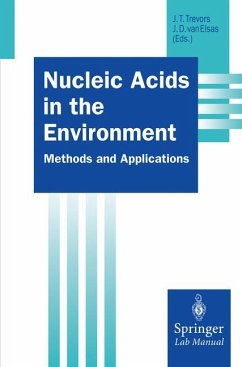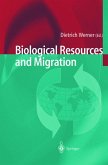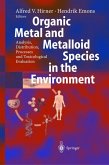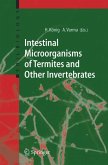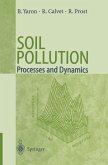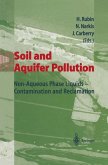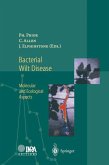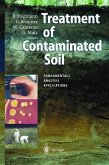Nucleic Acids in the Environment
Herausgegeben von Trevors, Jack T.; Elsas, J.Dick van
Nucleic Acids in the Environment
Herausgegeben von Trevors, Jack T.; Elsas, J.Dick van
- Broschiertes Buch
- Merkliste
- Auf die Merkliste
- Bewerten Bewerten
- Teilen
- Produkt teilen
- Produkterinnerung
- Produkterinnerung
Molecular biological techniques such as DNA/RNA extraction and purification, and especially the polymerase chain reaction, PCR, are rapidly gaining interest also in related fields, such as microbiology or environmental sciences. They offer new approaches and opportunities for the determination of microbial cells, DNA and RNA from soils, roots, rhizospheres, sediments and aquatic environments. Detailed protocols for these applications are described in this manual.
Andere Kunden interessierten sich auch für
![Biological Resources and Migration Biological Resources and Migration]() Dietrich Werner (ed.)Biological Resources and Migration153,99 €
Dietrich Werner (ed.)Biological Resources and Migration153,99 €![Organic Metal and Metalloid Species in the Environment Organic Metal and Metalloid Species in the Environment]() Alfred V. Hirner / Hendrik Emons (Hgg.)Organic Metal and Metalloid Species in the Environment121,99 €
Alfred V. Hirner / Hendrik Emons (Hgg.)Organic Metal and Metalloid Species in the Environment121,99 €![Intestinal Microorganisms of Termites and Other Invertebrates Intestinal Microorganisms of Termites and Other Invertebrates]() Helmut König / Ajit VarmaIntestinal Microorganisms of Termites and Other Invertebrates229,99 €
Helmut König / Ajit VarmaIntestinal Microorganisms of Termites and Other Invertebrates229,99 €![Soil Pollution Soil Pollution]() Bruno YaronSoil Pollution160,49 €
Bruno YaronSoil Pollution160,49 €![Soil and Aquifer Pollution Soil and Aquifer Pollution]() Soil and Aquifer Pollution161,99 €
Soil and Aquifer Pollution161,99 €![Bacterial Wilt Disease Bacterial Wilt Disease]() PriorBacterial Wilt Disease161,99 €
PriorBacterial Wilt Disease161,99 €![Treatment of Contaminated Soil Treatment of Contaminated Soil]() Rainer Stegmann / Gerd Brunner / Wolfgang Calmano / Gerhard Matz (eds.)Treatment of Contaminated Soil283,99 €
Rainer Stegmann / Gerd Brunner / Wolfgang Calmano / Gerhard Matz (eds.)Treatment of Contaminated Soil283,99 €-
-
-
Molecular biological techniques such as DNA/RNA extraction and purification, and especially the polymerase chain reaction, PCR, are rapidly gaining interest also in related fields, such as microbiology or environmental sciences. They offer new approaches and opportunities for the determination of microbial cells, DNA and RNA from soils, roots, rhizospheres, sediments and aquatic environments.
Detailed protocols for these applications are described in this manual.
Hinweis: Dieser Artikel kann nur an eine deutsche Lieferadresse ausgeliefert werden.
Detailed protocols for these applications are described in this manual.
Hinweis: Dieser Artikel kann nur an eine deutsche Lieferadresse ausgeliefert werden.
Produktdetails
- Produktdetails
- Springer Lab Manual
- Verlag: Springer / Springer Berlin Heidelberg / Springer, Berlin
- Artikelnr. des Verlages: 978-3-540-58069-0
- 1995.
- Seitenzahl: 272
- Erscheinungstermin: 28. April 1995
- Englisch
- Abmessung: 235mm x 155mm x 15mm
- Gewicht: 448g
- ISBN-13: 9783540580690
- ISBN-10: 3540580697
- Artikelnr.: 25402013
- Herstellerkennzeichnung Die Herstellerinformationen sind derzeit nicht verfügbar.
- Springer Lab Manual
- Verlag: Springer / Springer Berlin Heidelberg / Springer, Berlin
- Artikelnr. des Verlages: 978-3-540-58069-0
- 1995.
- Seitenzahl: 272
- Erscheinungstermin: 28. April 1995
- Englisch
- Abmessung: 235mm x 155mm x 15mm
- Gewicht: 448g
- ISBN-13: 9783540580690
- ISBN-10: 3540580697
- Artikelnr.: 25402013
- Herstellerkennzeichnung Die Herstellerinformationen sind derzeit nicht verfügbar.
1 Introduction to Nucleic Acids in the Environment: Methods and Applications.
1.1 Introduction.
1.2 Cell Lysis, Nucleic Acid Extraction and Purification Protocols.
1.3 Analysis of Environmental Nucleic Acids.
1.4 Concluding Remarks.
References.
2 Recovery of Bacterial Cells from Soil.
2.1 Introduction.
2.2 Strategies for Cell Extraction.
2.3 Recommended Methods.
2.4 Practical Experiences and Recommendations.
References.
3 Extraction, Purification, and Analysis of DNA from Soil Bacteria.
3.1 Introduction.
3.2 Bacterial DNA.
3.3 Direct Extraction of DNA from Soil.
3.4 Purity Control and Characterization of Soil Bacterial DNA.
References.
4 Extraction and Analysis of Microbial DNA from Soil.
4.1 Introduction.
4.2 DNA Extraction Methods.
4.3 Evaluation of DNA Extraction Methods.
4.4 Methods for Analysis of DNA from Soil.
4.5 Concluding Remarks.
References.
5 Extraction and Amplification of DNA from the Rhizosphere and Rhizoplane of Plants.
5.1 Introduction.
5.2 Sample Preparation.
5.3 Extraction, Purification and Quantification of DNA from the Rhizosphere.
5.4 PCR Analysis of Bacterial DNA from the Rhizosphere and Rhizoplane of Plants.
5.5 Concluding Remarks.
References.
6 Extraction of DNA from the Phyllosphere.
6.1 Introduction.
6.2 Materials, Methods and Protocols.
6.3 Concluding Remarks.
References.
7 Specific DNA Sequences for Detection of Soil Bacteria.
7.1 Introduction.
7.2 Objectives and Limitations.
7.3 Target DNA, DNA Extraction and Detection in Soil.
7.4 Detailed Procedures.
7.5 Application of Methodology.
References.
8 PCR Amplification of DNA from Root Nodules.
8.1 Introduction.
8.2 Methods for Detection of Rhizobia.
8.3 Detection of Root Nodule Bacteria by PCR.
8.4 Conclusions.
References.
9 Extraction of DNA and RNA from Aquatic Environments.
9.1 Introduction.
9.2 DNA as a Biomass and Ecological Indicator.
9.3 RNA as a Biomass and Ecological Indicator.
9.4 Biomass and Activity Measurements of Aquatic Microorganisms using RNA and RNA /DNA Ratios.
9.5 Extraction of Nucleic Acids for Molecular Biological Studies.
9.6 Molecular Methods for Studying RNA in Aquatic Environments.
9.7 Extraction of DNA from Aquatic Microbial Populations.
9.8 Extraction of RNA from Aquatic Microbial Populations.
References.
10 PCR Amplification of DNA Recovered from the Aquatic Environment.
10.1 Introduction.
10.2 Concentration of Water Samples from Aquatic Environments.
10.3 Sample Preparation for PCR Amplification.
10.4 Processing of Dissolved DNA in the Aquatic Environment.
10.5 Processing of Nucleic Acids from Biofilms.
10.6 PCR Amplification.
10.7 Identification and Analysis of the Amplified DNA.
10.8 PCR Contamination Control.
10.9 Enhancing the Specificity of the PCR Reaction.
10.10 Use of Arbitrarily Primed PCR (Ap
PCR) in Environmental Microbiology.
10.11 In situ PCR Amplification.
10.12 The Use of PCR in Aquatic Environments.
10.13 Detection of Viruses in Water.
10.14 Discussion.
References.
11 Extraction and Amplification of 16S rRNA Genes from Deep Marine Sediments and Seawater to Assess Bacterial Community Diversity.
11.1 Introduction.
11.2 DNA Extraction.
11.3 Amplification of 16S Ribosomal RNA Gene Sequences.
11.4 Cloning and Sequencing.
11.5 Sequences Obtained from Marine Sediments and Coastal Waters.
References.
12 Application of the PCR for Detection of Antibiotic Resistance Genes in Environmental Samples.
12.1 Introduction.
12.2 Selection of PCR Primers and Gene Probes for Specific Detection of sat and nptII Genes.
12.3 Detection of Antibiotic Resistance Genes in Bacterial Isolates Using PCR.
12.4 Detection of Antibiotic Resistance Genes Using DNA Extraction and PCR.
12.5 Detection of Antibiotic Resistance Genes in Total Community DNA Extracts from Environmental Habitats..
12.6 Conclusions.
References.
1.1 Introduction.
1.2 Cell Lysis, Nucleic Acid Extraction and Purification Protocols.
1.3 Analysis of Environmental Nucleic Acids.
1.4 Concluding Remarks.
References.
2 Recovery of Bacterial Cells from Soil.
2.1 Introduction.
2.2 Strategies for Cell Extraction.
2.3 Recommended Methods.
2.4 Practical Experiences and Recommendations.
References.
3 Extraction, Purification, and Analysis of DNA from Soil Bacteria.
3.1 Introduction.
3.2 Bacterial DNA.
3.3 Direct Extraction of DNA from Soil.
3.4 Purity Control and Characterization of Soil Bacterial DNA.
References.
4 Extraction and Analysis of Microbial DNA from Soil.
4.1 Introduction.
4.2 DNA Extraction Methods.
4.3 Evaluation of DNA Extraction Methods.
4.4 Methods for Analysis of DNA from Soil.
4.5 Concluding Remarks.
References.
5 Extraction and Amplification of DNA from the Rhizosphere and Rhizoplane of Plants.
5.1 Introduction.
5.2 Sample Preparation.
5.3 Extraction, Purification and Quantification of DNA from the Rhizosphere.
5.4 PCR Analysis of Bacterial DNA from the Rhizosphere and Rhizoplane of Plants.
5.5 Concluding Remarks.
References.
6 Extraction of DNA from the Phyllosphere.
6.1 Introduction.
6.2 Materials, Methods and Protocols.
6.3 Concluding Remarks.
References.
7 Specific DNA Sequences for Detection of Soil Bacteria.
7.1 Introduction.
7.2 Objectives and Limitations.
7.3 Target DNA, DNA Extraction and Detection in Soil.
7.4 Detailed Procedures.
7.5 Application of Methodology.
References.
8 PCR Amplification of DNA from Root Nodules.
8.1 Introduction.
8.2 Methods for Detection of Rhizobia.
8.3 Detection of Root Nodule Bacteria by PCR.
8.4 Conclusions.
References.
9 Extraction of DNA and RNA from Aquatic Environments.
9.1 Introduction.
9.2 DNA as a Biomass and Ecological Indicator.
9.3 RNA as a Biomass and Ecological Indicator.
9.4 Biomass and Activity Measurements of Aquatic Microorganisms using RNA and RNA /DNA Ratios.
9.5 Extraction of Nucleic Acids for Molecular Biological Studies.
9.6 Molecular Methods for Studying RNA in Aquatic Environments.
9.7 Extraction of DNA from Aquatic Microbial Populations.
9.8 Extraction of RNA from Aquatic Microbial Populations.
References.
10 PCR Amplification of DNA Recovered from the Aquatic Environment.
10.1 Introduction.
10.2 Concentration of Water Samples from Aquatic Environments.
10.3 Sample Preparation for PCR Amplification.
10.4 Processing of Dissolved DNA in the Aquatic Environment.
10.5 Processing of Nucleic Acids from Biofilms.
10.6 PCR Amplification.
10.7 Identification and Analysis of the Amplified DNA.
10.8 PCR Contamination Control.
10.9 Enhancing the Specificity of the PCR Reaction.
10.10 Use of Arbitrarily Primed PCR (Ap
PCR) in Environmental Microbiology.
10.11 In situ PCR Amplification.
10.12 The Use of PCR in Aquatic Environments.
10.13 Detection of Viruses in Water.
10.14 Discussion.
References.
11 Extraction and Amplification of 16S rRNA Genes from Deep Marine Sediments and Seawater to Assess Bacterial Community Diversity.
11.1 Introduction.
11.2 DNA Extraction.
11.3 Amplification of 16S Ribosomal RNA Gene Sequences.
11.4 Cloning and Sequencing.
11.5 Sequences Obtained from Marine Sediments and Coastal Waters.
References.
12 Application of the PCR for Detection of Antibiotic Resistance Genes in Environmental Samples.
12.1 Introduction.
12.2 Selection of PCR Primers and Gene Probes for Specific Detection of sat and nptII Genes.
12.3 Detection of Antibiotic Resistance Genes in Bacterial Isolates Using PCR.
12.4 Detection of Antibiotic Resistance Genes Using DNA Extraction and PCR.
12.5 Detection of Antibiotic Resistance Genes in Total Community DNA Extracts from Environmental Habitats..
12.6 Conclusions.
References.
1 Introduction to Nucleic Acids in the Environment: Methods and Applications.
1.1 Introduction.
1.2 Cell Lysis, Nucleic Acid Extraction and Purification Protocols.
1.3 Analysis of Environmental Nucleic Acids.
1.4 Concluding Remarks.
References.
2 Recovery of Bacterial Cells from Soil.
2.1 Introduction.
2.2 Strategies for Cell Extraction.
2.3 Recommended Methods.
2.4 Practical Experiences and Recommendations.
References.
3 Extraction, Purification, and Analysis of DNA from Soil Bacteria.
3.1 Introduction.
3.2 Bacterial DNA.
3.3 Direct Extraction of DNA from Soil.
3.4 Purity Control and Characterization of Soil Bacterial DNA.
References.
4 Extraction and Analysis of Microbial DNA from Soil.
4.1 Introduction.
4.2 DNA Extraction Methods.
4.3 Evaluation of DNA Extraction Methods.
4.4 Methods for Analysis of DNA from Soil.
4.5 Concluding Remarks.
References.
5 Extraction and Amplification of DNA from the Rhizosphere and Rhizoplane of Plants.
5.1 Introduction.
5.2 Sample Preparation.
5.3 Extraction, Purification and Quantification of DNA from the Rhizosphere.
5.4 PCR Analysis of Bacterial DNA from the Rhizosphere and Rhizoplane of Plants.
5.5 Concluding Remarks.
References.
6 Extraction of DNA from the Phyllosphere.
6.1 Introduction.
6.2 Materials, Methods and Protocols.
6.3 Concluding Remarks.
References.
7 Specific DNA Sequences for Detection of Soil Bacteria.
7.1 Introduction.
7.2 Objectives and Limitations.
7.3 Target DNA, DNA Extraction and Detection in Soil.
7.4 Detailed Procedures.
7.5 Application of Methodology.
References.
8 PCR Amplification of DNA from Root Nodules.
8.1 Introduction.
8.2 Methods for Detection of Rhizobia.
8.3 Detection of Root Nodule Bacteria by PCR.
8.4 Conclusions.
References.
9 Extraction of DNA and RNA from Aquatic Environments.
9.1 Introduction.
9.2 DNA as a Biomass and Ecological Indicator.
9.3 RNA as a Biomass and Ecological Indicator.
9.4 Biomass and Activity Measurements of Aquatic Microorganisms using RNA and RNA /DNA Ratios.
9.5 Extraction of Nucleic Acids for Molecular Biological Studies.
9.6 Molecular Methods for Studying RNA in Aquatic Environments.
9.7 Extraction of DNA from Aquatic Microbial Populations.
9.8 Extraction of RNA from Aquatic Microbial Populations.
References.
10 PCR Amplification of DNA Recovered from the Aquatic Environment.
10.1 Introduction.
10.2 Concentration of Water Samples from Aquatic Environments.
10.3 Sample Preparation for PCR Amplification.
10.4 Processing of Dissolved DNA in the Aquatic Environment.
10.5 Processing of Nucleic Acids from Biofilms.
10.6 PCR Amplification.
10.7 Identification and Analysis of the Amplified DNA.
10.8 PCR Contamination Control.
10.9 Enhancing the Specificity of the PCR Reaction.
10.10 Use of Arbitrarily Primed PCR (Ap
PCR) in Environmental Microbiology.
10.11 In situ PCR Amplification.
10.12 The Use of PCR in Aquatic Environments.
10.13 Detection of Viruses in Water.
10.14 Discussion.
References.
11 Extraction and Amplification of 16S rRNA Genes from Deep Marine Sediments and Seawater to Assess Bacterial Community Diversity.
11.1 Introduction.
11.2 DNA Extraction.
11.3 Amplification of 16S Ribosomal RNA Gene Sequences.
11.4 Cloning and Sequencing.
11.5 Sequences Obtained from Marine Sediments and Coastal Waters.
References.
12 Application of the PCR for Detection of Antibiotic Resistance Genes in Environmental Samples.
12.1 Introduction.
12.2 Selection of PCR Primers and Gene Probes for Specific Detection of sat and nptII Genes.
12.3 Detection of Antibiotic Resistance Genes in Bacterial Isolates Using PCR.
12.4 Detection of Antibiotic Resistance Genes Using DNA Extraction and PCR.
12.5 Detection of Antibiotic Resistance Genes in Total Community DNA Extracts from Environmental Habitats..
12.6 Conclusions.
References.
1.1 Introduction.
1.2 Cell Lysis, Nucleic Acid Extraction and Purification Protocols.
1.3 Analysis of Environmental Nucleic Acids.
1.4 Concluding Remarks.
References.
2 Recovery of Bacterial Cells from Soil.
2.1 Introduction.
2.2 Strategies for Cell Extraction.
2.3 Recommended Methods.
2.4 Practical Experiences and Recommendations.
References.
3 Extraction, Purification, and Analysis of DNA from Soil Bacteria.
3.1 Introduction.
3.2 Bacterial DNA.
3.3 Direct Extraction of DNA from Soil.
3.4 Purity Control and Characterization of Soil Bacterial DNA.
References.
4 Extraction and Analysis of Microbial DNA from Soil.
4.1 Introduction.
4.2 DNA Extraction Methods.
4.3 Evaluation of DNA Extraction Methods.
4.4 Methods for Analysis of DNA from Soil.
4.5 Concluding Remarks.
References.
5 Extraction and Amplification of DNA from the Rhizosphere and Rhizoplane of Plants.
5.1 Introduction.
5.2 Sample Preparation.
5.3 Extraction, Purification and Quantification of DNA from the Rhizosphere.
5.4 PCR Analysis of Bacterial DNA from the Rhizosphere and Rhizoplane of Plants.
5.5 Concluding Remarks.
References.
6 Extraction of DNA from the Phyllosphere.
6.1 Introduction.
6.2 Materials, Methods and Protocols.
6.3 Concluding Remarks.
References.
7 Specific DNA Sequences for Detection of Soil Bacteria.
7.1 Introduction.
7.2 Objectives and Limitations.
7.3 Target DNA, DNA Extraction and Detection in Soil.
7.4 Detailed Procedures.
7.5 Application of Methodology.
References.
8 PCR Amplification of DNA from Root Nodules.
8.1 Introduction.
8.2 Methods for Detection of Rhizobia.
8.3 Detection of Root Nodule Bacteria by PCR.
8.4 Conclusions.
References.
9 Extraction of DNA and RNA from Aquatic Environments.
9.1 Introduction.
9.2 DNA as a Biomass and Ecological Indicator.
9.3 RNA as a Biomass and Ecological Indicator.
9.4 Biomass and Activity Measurements of Aquatic Microorganisms using RNA and RNA /DNA Ratios.
9.5 Extraction of Nucleic Acids for Molecular Biological Studies.
9.6 Molecular Methods for Studying RNA in Aquatic Environments.
9.7 Extraction of DNA from Aquatic Microbial Populations.
9.8 Extraction of RNA from Aquatic Microbial Populations.
References.
10 PCR Amplification of DNA Recovered from the Aquatic Environment.
10.1 Introduction.
10.2 Concentration of Water Samples from Aquatic Environments.
10.3 Sample Preparation for PCR Amplification.
10.4 Processing of Dissolved DNA in the Aquatic Environment.
10.5 Processing of Nucleic Acids from Biofilms.
10.6 PCR Amplification.
10.7 Identification and Analysis of the Amplified DNA.
10.8 PCR Contamination Control.
10.9 Enhancing the Specificity of the PCR Reaction.
10.10 Use of Arbitrarily Primed PCR (Ap
PCR) in Environmental Microbiology.
10.11 In situ PCR Amplification.
10.12 The Use of PCR in Aquatic Environments.
10.13 Detection of Viruses in Water.
10.14 Discussion.
References.
11 Extraction and Amplification of 16S rRNA Genes from Deep Marine Sediments and Seawater to Assess Bacterial Community Diversity.
11.1 Introduction.
11.2 DNA Extraction.
11.3 Amplification of 16S Ribosomal RNA Gene Sequences.
11.4 Cloning and Sequencing.
11.5 Sequences Obtained from Marine Sediments and Coastal Waters.
References.
12 Application of the PCR for Detection of Antibiotic Resistance Genes in Environmental Samples.
12.1 Introduction.
12.2 Selection of PCR Primers and Gene Probes for Specific Detection of sat and nptII Genes.
12.3 Detection of Antibiotic Resistance Genes in Bacterial Isolates Using PCR.
12.4 Detection of Antibiotic Resistance Genes Using DNA Extraction and PCR.
12.5 Detection of Antibiotic Resistance Genes in Total Community DNA Extracts from Environmental Habitats..
12.6 Conclusions.
References.

